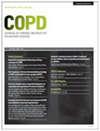Association of PM2.5 and PM10 with Acute Exacerbation of Chronic Obstructive Pulmonary Disease at lag0 to lag7: A Systematic Review and Meta-Analysis
IF 2.1
4区 医学
Q3 RESPIRATORY SYSTEM
COPD: Journal of Chronic Obstructive Pulmonary Disease
Pub Date : 2022-05-26
DOI:10.1080/15412555.2022.2070062
引用次数: 6
Abstract
Abstract This study aimed to conduct a meta-analysis to investigate whether short-term exposure to fine (PM2.5) and coarse (PM10) particulate matter was associated with acute exacerbation of chronic obstructive pulmonary disease (AECOPD) hospitalization, emergency room visit, and outpatient visit at different lag values. PubMed, Embase, and the Cochrane Library were searched for relevant papers published up to March 2021. For studies reporting results per 1-µg/m3 increase in PM2.5, the results were recalculated as per 10-µg/m3 increase. We manually calculated the RRs for these two studies and transferred the RRs to estimate 10 µg/m3 increases in PM2.5. Automation tools were initially used to remove ineligible studies. Two reviewers independently screened the remaining records and retrieved reports. Twenty-six studies (28 datasets; 7,018,419 patients) were included. There was a significant association between PM2.5 and AECOPD events on lag0 (ES = 1.01, 95%CI: 1.01-1.02, p < 0.001; I2=88.6%, Pheterogeneity<0.001), lag1 (ES = 1.00, 95%CI: 1.00-1.01, p < 0.001; I2=82.5%, Pheterogeneity<0.001), lag2 (ES = 1.01, 95%CI: 1.01-1.01, p < 0.001; I2=90.6%, Pheterogeneity<0.001), lag3 (ES = 1.01, 95%CI: 1.00-1.01, p < 0.001; I2=88.9%, Pheterogeneity<0.001), lag4 (ES = 1.00, 95%CI: 1.00-1.01, p < 0.001; I2=83.7%, Pheterogeneity<0.001), and lag7 (ES = 1.00, 95%CI: 1.00-1.00, p < 0.001; I2=0.0%, Pheterogeneity=0.743). The subgroup analyses showed that PM2.5 influenced the rates of hospitalization, emergency room visits, and outpatient visits. Similar trends were observed with PM10. The risk of AECOPD events (hospitalization, emergency room visit, and outpatient visit) was significantly increased with a 10-µg/m3 increment in PM2.5 and PM10 from lag0 to lag7. List Of Abbreviations: particulate matter (PM2.5 and PM10); acute exacerbation of chronic obstructive pulmonary disease (AECOPD); Chronic obstructive pulmonary disease (COPD); Preferred Reporting Items for Systematic Reviews and Meta-Analyses (PRISMA); Effect sizes [48]; confidence intervals (CIs)PM2.5和PM10与慢性阻塞性肺疾病急性加重在lag0至lag7的关联:一项系统综述和荟萃分析
摘要本研究旨在通过荟萃分析,探讨不同滞后值下短期暴露细颗粒物(PM2.5)和粗颗粒物(PM10)与慢性阻塞性肺疾病(AECOPD)急性加重期住院、急诊和门诊就诊是否相关。检索PubMed、Embase和Cochrane图书馆,检索截止到2021年3月发表的相关论文。对于报告PM2.5每增加1µg/m3结果的研究,结果按每增加10µg/m3重新计算。我们手动计算了这两项研究的相对危险度,并将相对危险度转移到PM2.5增加10微克/立方米的估计上。自动化工具最初用于删除不合格的研究。两个审阅者独立地筛选剩余的记录并检索报告。26项研究(28个数据集;包括7,018,419例患者)。PM2.5与lag0 AECOPD事件有显著相关性(ES = 1.01, 95%CI: 1.01 ~ 1.02, p < 0.001;I2=88.6%,异质性<0.001),lag1 (ES = 1.00, 95%CI: 1.00-1.01, p <0.001;I2=82.5%,异质性<0.001),lag2 (ES = 1.01, 95%CI: 1.01 ~ 1.01, p <0.001;I2=90.6%,异质性<0.001),lag3 (ES = 1.01, 95%CI: 1.00-1.01, p <0.001;I2=88.9%,异质性<0.001),lag4 (ES = 1.00, 95%CI: 1.00-1.01, p <0.001;I2=83.7%,异质性<0.001),lag7 (ES = 1.00, 95%CI: 1.00-1.00, p <0.001;I2 = 0.0%, Pheterogeneity = 0.743)。亚组分析显示,PM2.5影响了住院率、急诊室就诊率和门诊就诊率。PM10也出现了类似的趋势。从lag0到lag7, PM2.5和PM10每增加10µg/m3, AECOPD事件(住院、急诊和门诊)的风险显著增加。缩写词列表:颗粒物(PM2.5、PM10);慢性阻塞性肺疾病急性加重(AECOPD);慢性阻塞性肺病(COPD);系统评价和荟萃分析(PRISMA)首选报告项目;效应量[48];置信区间(ci)
本文章由计算机程序翻译,如有差异,请以英文原文为准。
求助全文
约1分钟内获得全文
求助全文
来源期刊

COPD: Journal of Chronic Obstructive Pulmonary Disease
RESPIRATORY SYSTEM-
CiteScore
4.40
自引率
0.00%
发文量
38
审稿时长
6-12 weeks
期刊介绍:
From pathophysiology and cell biology to pharmacology and psychosocial impact, COPD: Journal Of Chronic Obstructive Pulmonary Disease publishes a wide range of original research, reviews, case studies, and conference proceedings to promote advances in the pathophysiology, diagnosis, management, and control of lung and airway disease and inflammation - providing a unique forum for the discussion, design, and evaluation of more efficient and effective strategies in patient care.
 求助内容:
求助内容: 应助结果提醒方式:
应助结果提醒方式:


